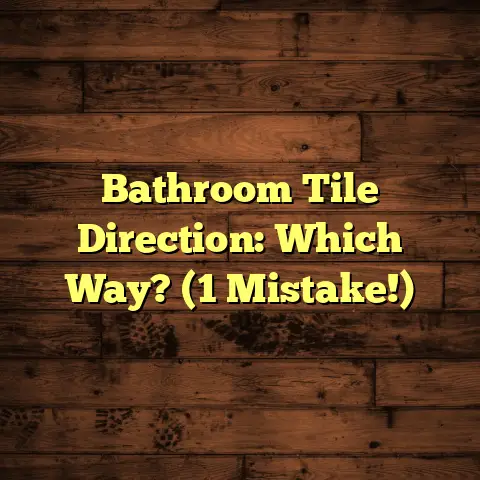Why Are Floors Slippery? (9 Fixes Now!)
Did you know that slips, trips, and falls account for over 8 million emergency room visits each year in the United States alone? (Source: National Safety Council). That’s a staggering number, and it really highlights how important it is to tackle this problem.
Let’s dive into why your floors might be trying to betray you and, more importantly, how to fix them.
Understanding Floor Slipperiness
Okay, so what exactly makes a floor slippery? It all boils down to friction, or rather, the lack of it. Friction is the force that resists motion between two surfaces.
Think of it this way: your shoe and the floor. If there’s good friction, your shoe grips the floor, and you can walk safely. But if friction is low, your shoe slides, and you risk a fall.
Now, different flooring materials have different levels of inherent slip resistance. Let’s break down some common types:
-
Tile: Tile, especially polished tile, can be notoriously slippery, especially when wet.
-
Hardwood: Hardwood can be slippery depending on the finish. A high-gloss finish looks great but can be treacherous.
-
Laminate: Laminate often mimics hardwood but can sometimes be even more slippery, especially cheaper laminates.
-
Vinyl: Vinyl’s slip resistance varies. Some vinyl floors are designed with texture to improve grip, while others are smooth and slick.
-
Carpet: Carpet is generally the least slippery option, but even carpet can become slippery if it’s wet or has loose fibers.
Environmental factors play a huge role, too. Moisture is a major culprit, as is the type of cleaning products you use. Waxes and polishes, while intended to protect and shine, can also create a slippery surface if applied improperly or allowed to build up.
Common Causes of Slippery Floors
Let’s get down to the nitty-gritty. Why exactly are your floors so slippery? Here are some of the most common reasons I see:
-
Water and Moisture: This is the big one. Spills, leaks, tracked-in rain or snow – water reduces friction and makes floors slick. I can’t tell you how many times I’ve seen someone slip after coming in from a rainy day!
-
Improper Cleaning: Using the wrong cleaning product, or using too much, can leave a residue that makes the floor slippery. Some cleaners create a film that actually increases slipperiness.
-
Debris, Dust, and Dirt: Even small amounts of dirt and dust can act like tiny ball bearings under your feet, reducing friction. Think of it like walking on marbles!
-
Wax and Polish Buildup: I mentioned this earlier, but it’s worth repeating. Over time, wax and polish can build up, creating a slick, uneven surface.
-
Wear and Tear: As floors age, their surface can wear down, becoming smoother and more slippery. This is especially true in high-traffic areas.
-
Seasonal Factors: Ice and snow tracked indoors are obvious culprits. But even humidity can affect floor slipperiness, especially on certain types of flooring.
-
Inadequate Footwear: Walking barefoot or in socks on a smooth floor is a recipe for disaster. Socks, in particular, have very little grip.
The Risks Associated with Slippery Floors
Okay, so slippery floors are annoying, but are they really that dangerous? Unfortunately, the answer is a resounding yes. Here’s why:
-
Injuries from Falls: This is the most obvious risk. Falls can result in everything from minor bruises and sprains to serious fractures, head injuries, and even death, especially for elderly individuals. I’ve seen firsthand the devastating consequences of a simple slip.
-
Legal Implications for Businesses: If you own a business, slippery floors can open you up to lawsuits and liability. Negligence in maintaining safe walking surfaces can be costly.
-
Emotional and Psychological Impact: Falling is scary! Even a minor slip can lead to fear of falling, which can limit activity and reduce quality of life.
-
Economic Costs: Medical expenses, lost productivity, and legal fees associated with slip-and-fall accidents can add up quickly.
9 Effective Fixes for Slippery Floors
Alright, let’s get to the good stuff! Here are nine actionable fixes you can implement right now to make your floors safer:
-
Improve Floor Texture:
- Explanation: Consider textured flooring options like textured vinyl, or engineered hardwood.
- Benefits: Improves traction significantly, reducing slip risks.
- Challenges: May require floor replacement, which can be costly.
-
Use Non-Slip Mats and Runners:
- Explanation: Place mats in high-risk areas like entrances, kitchens, and bathrooms.
- Benefits: Provides instant traction and absorbs moisture.
- Challenges: Mats need regular cleaning and can be tripping hazards if not properly secured.
-
Adjust Cleaning Products:
- Explanation: Switch to non-slip floor cleaners that don’t leave residues. Look for pH-neutral options.
- Benefits: Reduces slipperiness without damaging the floor.
- Challenges: May require some experimentation to find the right product for your floor type.
-
Apply Slip-Resistant Coatings:
- Explanation: Apply a specialized coating designed to increase friction. These coatings are available for various floor types.
- Benefits: Provides a durable, long-lasting solution to slipperiness.
- Challenges: Requires careful application and may need to be reapplied periodically.
-
Implement Regular Maintenance:
- Explanation: Establish a routine cleaning schedule and inspect floors regularly for spills, debris, and wear.
- Benefits: Prevents buildup of slippery substances and identifies potential hazards early.
- Challenges: Requires commitment and attention to detail.
-
Upgrade Flooring Materials:
- Explanation: If your current flooring is inherently slippery, consider replacing it with a safer alternative, like textured vinyl or carpet.
- Benefits: Provides a permanent solution to slipperiness and improves overall safety.
- Challenges: Can be a significant investment.
-
Control Moisture Levels:
- Explanation: Use dehumidifiers in damp areas, fix leaks promptly, and encourage people to wipe their feet before entering the building.
- Benefits: Reduces the risk of slips caused by moisture.
- Challenges: Requires ongoing effort and attention.
-
Educate Household Members and Employees:
- Explanation: Train people on safe walking practices, like taking small steps and avoiding running on smooth surfaces.
- Benefits: Raises awareness and promotes a culture of safety.
- Challenges: Requires consistent reinforcement and communication.
-
Install Handrails and Grab Bars:
- Explanation: Install handrails in hallways and stairways, and grab bars in bathrooms, to provide support and prevent falls.
- Benefits: Provides extra stability and reduces the risk of serious injuries.
- Challenges: May require professional installation.
Conclusion
Slippery floors are a serious hazard, but they don’t have to be a fact of life. By understanding the causes of slipperiness and implementing the fixes I’ve outlined, you can significantly reduce the risk of accidents and create a safer environment for yourself, your family, or your employees.
Don’t wait for an accident to happen. Take proactive steps today to ensure your floors are safe and slip-resistant. Your peace of mind (and your bones!) will thank you.





